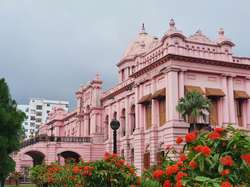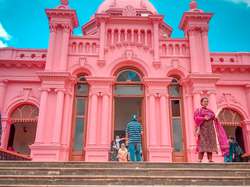Laser light show at Ahsan Manzil Museum
Hosted by Jubair Neel
Tweet ShareNestled along the banks of the Buriganga River in the heart of Dhaka, Bangladesh, lies a historical gem that has witnessed the ebb and flow of centuries—Ahsan Manzil. This architectural masterpiece, with its pink façade and distinct Indo-Saracenic design, stands not only as a symbol of grandeur but also as a living testament to the rich history of Dhaka City.
A Glimpse into the Past: Constructed in the late 19th century, Ahsan Manzil served as the official residence of the Nawabs of Dhaka. Commissioned by Nawab Abdul Ghani, and later expanded by his son Nawab Sir Khwaja Ahsanullah, the palace became an architectural marvel that blended Mughal, European, and Indo-Islamic influences.
The Pink Palace: Ahsan Manzil, often referred to as the "Pink Palace," owes its distinctive color to the use of Agra stone, which takes on a rosy hue over time. The palace features an imposing dome, ornate balconies, and intricately designed verandas, all of which contribute to its regal charm. The palace was strategically situated to overlook the river, symbolizing the historical significance of the Buriganga in the life of the city.
Dhaka: A City of Many Stories: To truly appreciate the significance of Ahsan Manzil, one must delve into the history of Dhaka itself. Once the capital of the Bengal region during the Mughal era, Dhaka has served as a cultural and economic hub for centuries. The city's evolution—from a Mughal trading post to the vibrant metropolis it is today—mirrors the changing tides of South Asian history.
Colonial Influences: During the colonial era, Dhaka witnessed the influence of various European powers, including the Portuguese, Dutch, and British. The architecture of Ahsan Manzil itself reflects this amalgamation of cultural influences. The palace stands as a tangible link to a bygone era, where the cityscape bore the imprints of both indigenous and foreign aesthetics.
Ahsan Manzil: A Witness to History: Throughout its existence, Ahsan Manzil has silently observed the shifting sands of time. From the heady days of Mughal grandeur to the turbulence of British colonial rule, and later the birth of an independent Bangladesh, the palace has stood as a silent sentinel, a repository of memories etched into its walls.
Preservation Efforts: In the face of urban development and modernization, Ahsan Manzil faced the threat of neglect. However, concerted efforts by the government and cultural preservation organizations have ensured the restoration and conservation of this historical treasure. Today, visitors can step into the past as they wander through the palace's rooms, each echoing with the whispers of a bygone era.
Conclusion: Ahsan Manzil is not merely a palace; it is a living chronicle of Dhaka's journey through time. As visitors explore its halls and courtyards, they are transported to an age where nawabs held court, and the river served as the lifeblood of a bustling city. Ahsan Manzil remains a bridge between the historical legacy of Dhaka and its vibrant present, inviting all who pass through its gates to partake in the city's rich tapestry of culture, resilience, and enduring beauty.
Comments
Attendees (1)
Jubair Neel Yes
HostPhotos
Ahsan Manzil Museum
Pink Ahsan Manzil Museum

